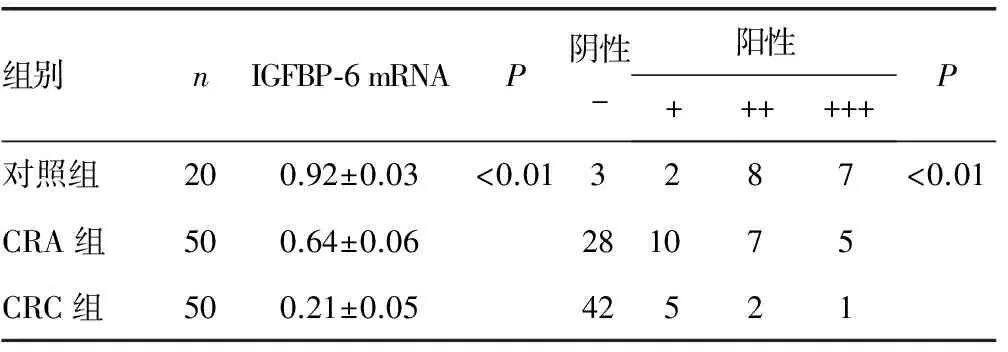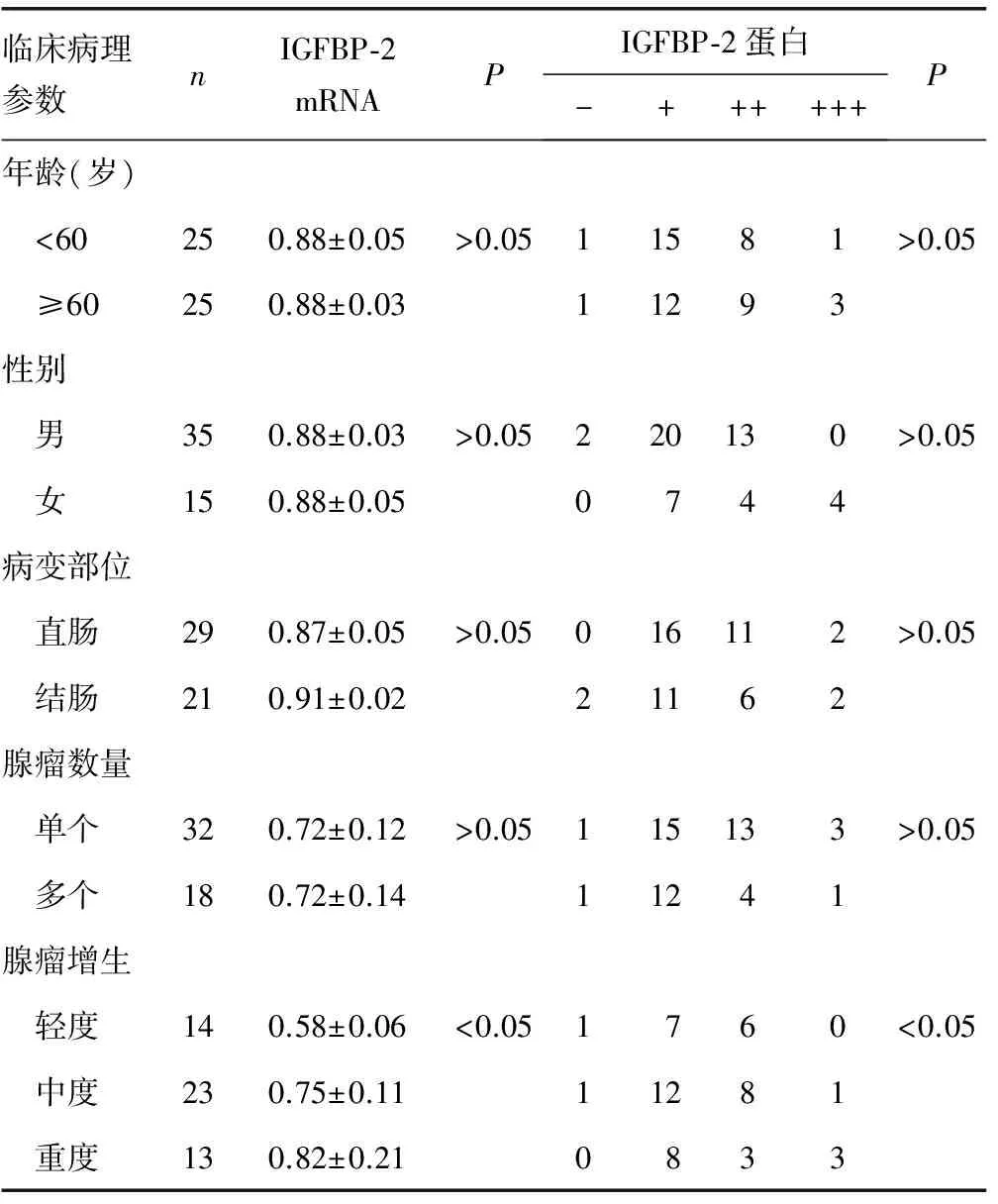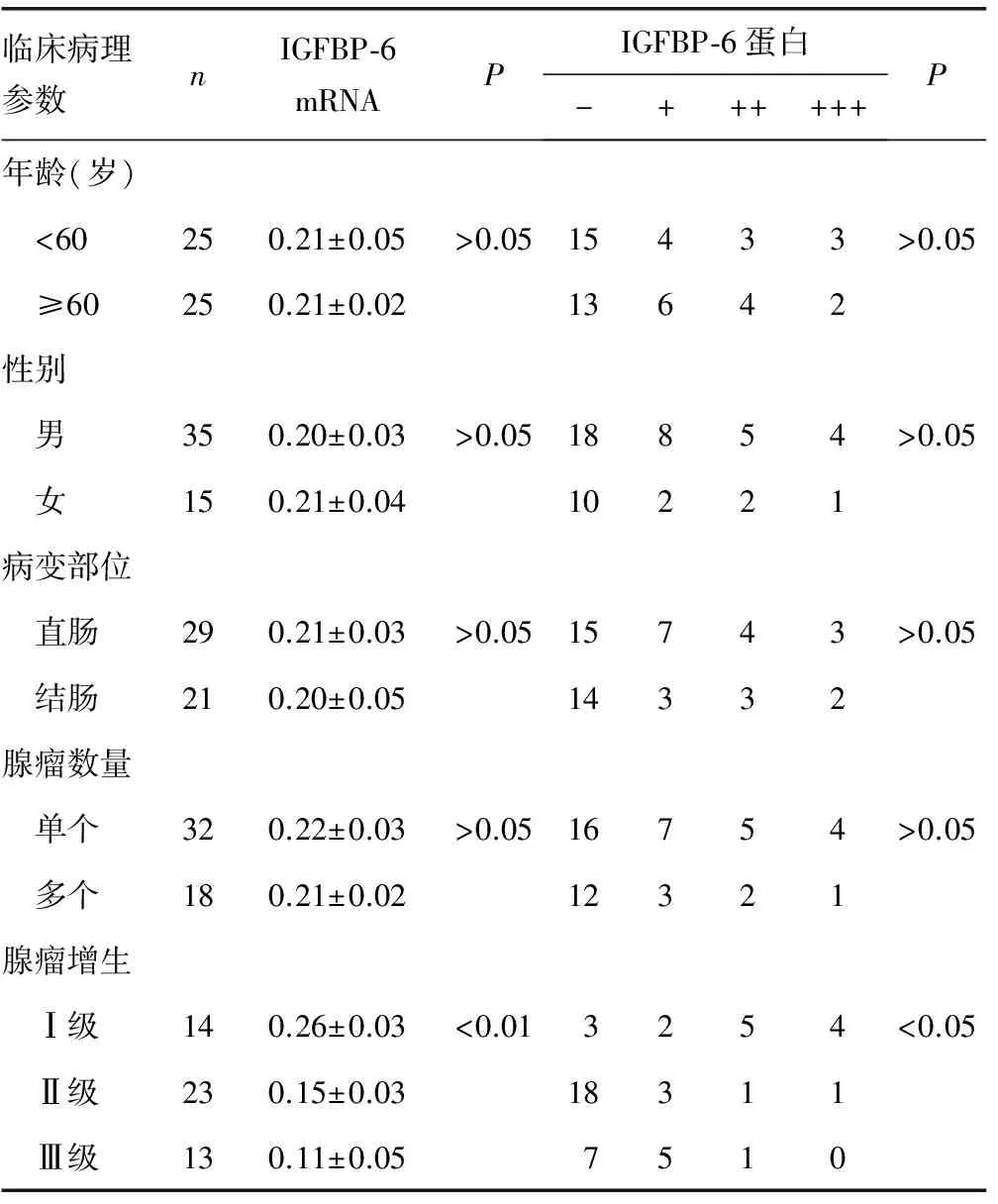IGFBP-2及IGFBP-6在结直肠腺瘤中的表达及意义的研究
薛 晶,赵 杨,张建伟,焦 艳,申兴斌△
(1.承德医学院附属医院病理科,河北承德 067000;2.承德医学院附属承钢医院病理科,河北承德 067000)
论著·临床研究
IGFBP-2及IGFBP-6在结直肠腺瘤中的表达及意义的研究
薛 晶1,赵 杨1,张建伟1,焦 艳2,申兴斌1△
(1.承德医学院附属医院病理科,河北承德 067000;2.承德医学院附属承钢医院病理科,河北承德 067000)
目的研究胰岛素样生长因子结合蛋白(IGFBP)-2及IGFBP-6在结直肠腺瘤(CRA)中的表达及临床意义。方法收集承德医学院附属医院2012年7月至2013年3月手术治疗后经病理证实为CRA 50例(CRA组)、结直肠癌(CRC)组织标本50例(CRC组),结直肠正常黏膜20例(对照组)。采用免疫组织化学法及RT-PCR方法检测IGFBP-2及IGFBP-6的蛋白及mRNA的表达情况,结合临床病理资料进行统计学分析。结果IGFBP-2蛋白的阳性表达及mRNA的表达量在CRA组与对照组比较有升高趋势;而与CRC组比较则有降低趋势,且差异有统计学意义(P<0.05),而IGFBP-6蛋白的阳性表达在CRA组与对照组比较有降低趋势;而与CRC组比较则有升高趋势,IGFBP-6 mRNA表达量在CRA组与对照组比较有升高趋势;而与CRC组比较则有降低趋势,且差异有统计学意义(P<0.05),在CRA组,IGFBP-2、IGFBP-6的阳性表达与患者的年龄、性别、肿瘤的数量及部位差异均无统计学意义(P>0.05),但是其与增生程度差异有统计学意义(P<0.05);在CRA组,IGFBP-2与IGFBP-6的表达相互间呈负相关,差异有统计学意义(P<0.01)。结论CRA在结直肠正常黏膜向CRC转化过程中的中间环节,而在其发生、发展过程中,胰岛素样生长因子家族(IGFs)与IGFS-R轴发挥着重要且不可替代的作用,所以IGFBP-2、IGFBP-6有可能作为CRA诊断及预后的早期预测指标。
结直肠腺瘤;胰岛素样生长因子结合蛋白2;胰岛素样生长因子结合蛋白6;免疫组织化学;逆转录聚合酶链反应
结直肠癌(colorectal cancer,CRC)是在消化系统最常见的恶性肿瘤之一,近年来,在我国其发病率及病死率呈增高趋势发展[1],西方国家其发病率居恶性肿瘤的第2~3位,而我国CRC的发病率居3~5位[2-3],CRC的发生、发展是一个多步骤、多阶段的过程,其形成原因是由多种因素发展形成,而结直肠腺瘤(colorectal adenoma,CRA)被认为是CRC的癌前病变,有研究表明,95%以上的CRC起源于CRA[4]。CRA的早期诊断及治疗可明显降低CRC的发病率及病死率[2-6]。多项研究提示[6-10]IGFs在多种肿瘤的发生、发展及转移中起着重要作用,但与CRA的关系还不是很明确。本文采用免疫组织化学及Rt-PCR方法检测胰岛素样生长因子结合蛋白(IGFBP)-2及IGFBP-6在CRA中的表达及其相互关系,现报道如下。
1 资料与方法
1.1 一般资料 选取2012年7月至2013年3月在承德医学院附属医院内镜室活检及手术后经病理证实为CRA患者瘤组织50例(CRA组),其中男35例,女15例,年龄27~71岁,平均(60.2±11.8)岁,外三科接受手术治疗后经病理证实为CRC患者组织标本50例(CRC组),CRC术后距癌组织大于10 cm的正常黏膜组织20例(对照组),3组患者的年龄、性别差异均无统计学意义(P>0.05),所有患者在接受治疗前均排除糖尿病、慢性肝病、糖皮质激素用药史等,CRC患者在手术前均未接受过放疗、化疗及免疫治疗。以上标本各取2份,一份甲醛固定,用于免疫组织化学,另一份取新鲜组织放于-80°冰箱用于RT-PCR。本文所用标本已经获得人体材料伦理审批及知情同意。
1.2 方法
1.2.1 免疫组织化学方法 采用MaxVision法,所取标本经4%甲醛固定后,常规脱水、包埋,对组织蜡块进行连续切片厚度为5 μm,一抗由武汉博士德生物工程有限公司购买,试剂盒购自福州迈新生物技术开发有限公司,抗体浓度均为1∶100,根据试剂盒的操作说明依次进行,除此设有PBS阴性对照组。以已知CRC阳性组织切片为阳性对照,以细胞膜及细胞质出现棕黄色颗粒为阳性反应,并采用Volm[2]双评分法进行判定,在染色均匀的肿瘤区,选取5个高倍镜视野(×400),(1)按阳性细胞百分率(A值)评分:<25%为1分, 25%~50%为2分,>50%为3分;(2)按染色强度(B值)评分,不着色为0分,浅棕黄色为1分,棕黄色为2分,棕褐色为3分,综合染色阳性细胞数(A值)与染色强度(B值)判断结果(A+B):阴性(-):0分,弱阳性(+):1~2分,中度阳性(++):3~4分,强阳性(+++):5~6分。
1.2.2 Rt-PCR法 用Trizol一步法提取RNA,用反转录酶AMV将RNA反转录成cDNA,IGFBP-2基因上游引物(5′-3′):GGT GTG TGA ACC CCA ACA;下游引物(5′-3′)GCC AAC ACC AAC ACT CTT TC,扩增产物:334 bp;IGFBP-6基因上游引物(5′-3′):CGA GGG GCT CAA ACA CTC TAC;下游引物(5′-3′):GCC AAC ACC AAC ACT CTT TC,扩增产物339 bp;β-actin为内参基因其上游引物(5′-3′):AGC GGG AAA TCG TGC GTG AC;下游引物(5-3′):ACA TCT GCT GGA AGG TGG AC;扩增产物:453 bp。取扩增产物4 μL用0.4 g琼脂糖与20 mL TBS配成凝胶电泳,通过EB染色后,在紫外荧光数字成像仪下照相,并进行吸光度定量分析,分别以每例IGFBP-2和IGFBP-6与相应β-actin扩增产物条带累积吸光度(IOD)的比值作为IGFBP-2和IGFBP-6 mRNA的相对表达量。

2 结 果
2.1 3组中IGFBP-2 mRNA及蛋白的表达
2.1.1 3组中IGFBP-2 mRNA的表达 对照组、CRA组和CRC组中均检测到IGFBP-2 mRNA的表达,其相对水平分别为0.39±0.05、0.60±0.05、0.89±0.03。3组两两比较,差异均有统计学意义(P<0.01),见表1。
2.1.2 3组中IGFBP-2蛋白的表达 IGFBP-2主要表达于结直肠正常黏膜、CRA及CRC细胞的细胞质及胞膜,在CRC组中,IGFBP-2均有表达,其中弱阳性13例(26.0%),中度阳性21例(42.0%),强阳性16例(32.0%);CRA组中阴性3例(6.0%),弱阳性27例(54%),中度阳性13例(26.0%),强阳性7例(14.0%);对照组中主要表达为阴性,仅有4例(20.0%)为轻度阳性。经秩和检验各组间均有明显差异(P<0.01) ,见表1。

表1 IGFBP-2蛋白在3组结直肠组织中的表达(%)
2.2 3组中IGFBP-6 mRNA及蛋白的表达
2.2.1 3组中IGFBP-6 mRNA的表达 在对照组、CRA组和CRC组组织中检测到IGFBP-6 mRNA的相对水平分别为0.92±0.03、0.64±0.06、0.21±0.05。两两比较各组间差异均有统计学意义(P<0.05),见表2。
2.2.2 3组中IGFBP-6蛋白的表达 IGFBP-6蛋白主要表达于CRA、CRC及正常黏膜组织细胞质及胞膜,在对照组织中IGFBP-6表达情况,阴性3例(15.0%),弱阳性2例(10.0%),中度阳性8例(40.0%)及强阳性7例(35.0%);CRA组织中IGFBP-6表达情况,28例阴性(56.0%),10例弱阳性(20.0%),7例中度阳性(14.0%),5例强阳性(10.0%);CRC组织中IGFBP-6表达情况,42例阴性(84.0%),,5例弱阳性(10.0%),2例中度阳性(4.0%),1例强阳性(2.0%)。经秩和检验各组间均有明显差异(P<0.05),见表2。

表2 IGFBP-6蛋白在3组结直肠组织中的表达(%)
2.3 IGFBP-2 mRNA及蛋白与CRA临床病理指标间的关系 CRA组增生程度中,IGFBP-2 mRNA的表达量及蛋白阳性表达与CRA的增生程度有关,表现为Ⅰ级大于Ⅱ级大于Ⅲ级,其差异有统计学意义(P<0.01);CRA组IGFBP-2 mRNA的表达量及蛋白阳性表达与患者性别、年龄、腺瘤数量及部位差异均无统计学意义(P>0.05),见表3。
2.4 IGFBP-6 mRNA及蛋白与CRA临床病理指标间的关系
2.4.1 CRA组增生程度中,IGFBP-6 mRNA的表达量CRA的增生程度有关,表现为重度大于中度大于轻度,其差异有统计学意义(P<0.01);CRA组IGFBP-6 mRNA的表达量及蛋白阳性表达与患者性别、年龄、腺瘤数量及部位差异均无统计学意义(P>0.05),见表4。
2.4.2 CRA组增生程度中,IGFBP-6阳性表达与CRA的增生程度有关,表现为轻度大于中度大于重度,其差异有统计学意义(P<0.01);CRA组IGFBP-6阳性表达与患者性别、年龄、腺瘤数量及部位差异均无统计学意义(P>0.05),见表4。

表3 IGFBP-2 mRNA与蛋白与结直肠腺瘤临床病理参数之间的关系

表4 IGFBP-6 mRNA与蛋白与CRA临床病理参数之间的关系
2.5 CRA组IGFBP-2及IGFBP-6在CRA组织中表达的相关性 IGFBP-2及IGFBP-6在CRA组呈负相关(r=-0.583,P<0.05)。
3 讨 论
3.1 IGFBP-2及IGFBP-6的生理功能 IGFBP-2可以在许多组织生产并存在于血清和其他生物体液中。出生后血浆中IGFBP-2水平在所有IGFBPs中排第2。IGFBP-2表达的调节受多种激素和生长因子的影响,已知调节IGFBP-2表达的激素包括GH、IGF-1、IGF-2、雌激素及胰岛素等[11]。
IGFBP-6是IGF家族中广泛分布于人体内但发现较晚、研究较少的蛋白。人IGFBP-6主要见于血清和脑脊液中,亦可表达于前列腺细胞、卵巢细胞和纤维母细胞等[12]。IGFBP-6作为一种分泌蛋白,独特之处就在于对IGF-Ⅱ的亲和力是IGF-I的20~100倍,表明其可以选择性与IGF-Ⅱ作用[13]。
3.2 IGFBP-2及IGFBP-6在大肠组织中的表达与病理学意义 众所周知,结直肠癌的发生是由一个漫长的过程,基本途径为正常黏膜-腺瘤-癌。结直肠癌细胞的发生大多是由腺瘤异型增殖以至发生癌变。
近年研究发现,IGFBP-2的高表达与多种肿瘤的发生有着密切的关系[14-16]。其具有许多独立于IGF之外的细胞作用,与肿瘤细胞生长、黏附、侵袭等相关[17]。本实验检测了IGFBP-2 mRNA及蛋白在CRA、CRC及正常黏膜中的表达,以及与CRA临床病理指标间的关系。近年研究发现,IGFBP-2的高表达与多种肿瘤的发生有着密切的关系[18-20]。其具有许多独立于IGF之外的细胞作用,与肿瘤细胞生长、黏附、侵袭等相关[21]。IGFBP-2的差异性表达在转录之前就已经发生,进而影响肿瘤的发生。本研究显示IGFBP-2在正常黏膜、CRA、CRC中的表达逐渐增强,说明IGFBP-2表达阳性的CRA组织,具有潜在的高风险向CRC演变发展,或者可以认为这种组织已经在癌前病变状态。本研究表明:在CRA中,IGFBP-2蛋白的阳性表达及mRNA的表达量随肿瘤的大小及腺瘤的增生程度的增加而逐渐增加,其差异有统计学意义(P<0.01)。
现有的实验研究结果表明,IGFBP-6或能通过与IGF-Ⅱ特异性结合发挥抑制IGF-Ⅱ所诱导的促进细胞分裂分化浸润转移的作用,是潜在的抗癌因子,这种抑制作用在骨肉瘤、神经母细胞瘤、肺癌及横纹肌肉瘤等肿瘤细胞体外实验中都得到了证实[22-24],体内外实验表明IGFBP-6可抑制横纹肌肉瘤的增生和转移,并诱发其凋亡。重组的IGFBP-6可以抑制体外细胞增殖,而这种效应可以被IGFBP-6的抗体抑制[25],提示IGFBP-6可能是一种抑制肿瘤发生、发展的肿瘤抑制因子。在本研究中IGFBP-6蛋白的阳性表达及mRNA的表达量随肿瘤的大小及CRA的增生程度的增加而逐渐减弱,其差异有统计学意义(P<0.01)。在CRA组IGFBP-2及IGFBP-6的阳性表达与患者年龄、性别、数量及部位差异均无统计学意义(P>0.05)。
3.3 CRA组IGFBP-2及IGFBP-6在CRA组织中表达的相关性 IGFBP-2及IGFBP-6在CRA组呈负相关(r=-0.583,P<0.05),即随着IGFBP-2的蛋白的阳性表达及mRNA的表达量的增强,IGFBP-6的蛋白的阳性表达及mRNA的表达量的减弱。
综上所述,CRA在结直肠正常黏膜向CRC转化过程中的中间环节,而在其发生、发展过程中IGFs与IGFS-R轴发挥着重要且不可替代的作用,所以IGFBP-2、IGFBP-6有可能作为CRA诊断及预后的早期预测指标,对CRA的临床研究有重要意义。
[1]万德森.我国结直肠癌的流行趋势及对策[J].中华肿瘤杂志,2011,33(7):481-483.
[2]中华医学会消化病学分会.中国结直肠肿瘤筛查,早诊早治和综合预防共识意见[J].胃肠病学和肝病学杂志,2011,20(11):979-995.
[3]Bretthauer M.Colorectal cancer screening[J].J Intern Med,2011,270(2):87-98.
[4]宋猛.结直肠高危腺瘤患者危险因素的调查[J].中国现代医生,2012,50(22):17-18,21.
[5]Wong VW,Wong GL,Tsang SW,et al.High prevalence of colorectal neoplasm in patients with non-alcoholic steatohepatitis[J].Gut,2011,60(6):829-836.
[6]崔艳欣,姜常青,王瑶,等.结直肠腺瘤患者血清IGF-1和IGFBP-3的变化及其临床意义[J].世界华人消化杂志,2012,20(26):2529-2533.
[7]Jacob JS,Mcdonald HS.Diving bradycardia in four species of North American aquatic snakes[J].Comp Biochem Physiol A Comp Physiol,1976,53(1):69-72.
[8]Endogenous Hormones and Breast Cancer Collaborative Group,Key TJ,Appleby PN,et al.Insulin-like growth factor 1 (IGF1),IGF binding protein 3 (IGFBP3),and breast cancer risk:pooled individual data analysis of 17 prospective studies[J].Lancet Oncol,2010,11(6):530-542.
[9]Rinaldi S,Cleveland R,Norat T,et al.Serum levels of IGF-I,IGFBP-3 and colorectal cancer risk:results from the EPIC cohort,plus a meta-analysis of prospective studies[J].Int J Cancer,2010,126(7):1702-1715.
[10]Cui H.Loss of imprinting of IGF2 as an epigenetic marker for the risk of human cancer[J].Dis Markers,2007,23(1/2):105-112.
[11]Cardona-Gómez GP,Chowen JA,Garcia-Segura LM.Estradiol and progesterone regulate the expression of insulin-like growth factor-I receptor and insulin-like growth factor binding protein-2 in the hypothalamus of adult female rats[J].J Neurobiol,2000,43(3):269-281.
[12]Qiu J,Ma XL,Wang X,et al.Insulin-like growth factor binding protein-6 interacts with the thyroid hormone receptor α1 and modulates the thyroid hormone-response in osteoblastic differentiation[J].Mol Cell Biochem,2012,361(1/2):197-208.
[13]Renehan AG,Jones J,Potten CS,et al.Elevated serum insulin-like growth factor (IGF)-Ⅱ and IGF binding protein-2 in patients with colorectal cancer[J].Br J Cancer,2000,83(10):1344-1350.
[14]Huynh H,Iizuka S,Kaba M,et al.Insulin-like growth factor-binding protein 2 secreted by a tumorigenic cell line supports ex vivo expansion of mouse hematopoietic stem cells[J].Stem Cells,2008,26(6):1628-1635.
[15]Mehrian-Shai R,Chen CD,Shi T,et al.Insulin growth factor-binding protein 2 is a candidate biomarker for PTEN status and PI3K/Akt pathway activation in glioblastoma and prostate cancer[J].Proc Natl Acad Sci U S A,2007,104(13):5563-5568.
[16]Miyako K,Cobb LJ,Francis M,et al.PAPA-1 is a nuclear binding partner of IGFBP-2 and modulates its growth-promoting actions[J].Mol Endocrinol,2009,23(2):169-175.
[17]Breves JP,Tipsmark CK,Stough BA,et al.Nutritional status and growth hormone regulate insulin-like growth factor binding protein (igfbp) transcripts in Mozambique tilapia[J].Gen Comp Endocrinol,2014(207):66-73.
[18]Zhang L,Huang W,Chen J,et al.Expression of IGFBP2 in gastric carcinoma and relationship with clinicopathologic parameters and cell proliferation[J].Dig Dis Sci,2007,52(1):248-253.
[19]Huynh H,Iizuka S,Kaba M,et al.Insulin-like growth factor-binding protein 2 secreted by a tumorigenic cell line supports ex vivo expansion of mouse hematopoietic stem cells[J].Stem Cells,2008,26(6):1628-1635.
[20]Miyako K,Cobb LJ,Francis M,et al.PAPA-1 is a nuclear binding partner of IGFBP-2 and modulates its growth-promoting actions[J].Mol Endocrinol,2009,23(2):169-175.
[21]Hoeflich A,Fettscher O,Lahm H,et al.Overexpression of insulin-like growth factor-binding protein-2 results in increased tumorigenic potential in Y-1 adrenocortical tumor cells[J].Cancer Res,2000,60(4):834-838.
[22]陈秋燕,卢奕,张健,等.IGFBP-6与晚期鼻咽癌患者预后的关系以及在鼻咽癌细胞株CNE2增殖中的作用[J].中山大学学报:医学科学版,2010,31(4):525-529,544.
[23]Howarth GS.Insulin-like growth factor-Ⅰ and the gastrointestinal system:therapeutic indications and safety implications[J].J Nutr,2003,133(7):2109-2112.
[24]Leng SL,Leeding KS,Whitehead RH,et al.Insulin-like growth factor(IGF)-binding protein-6 inhibits-IGF-Ⅱ-induced but not basal proliferation and adhesion of LIMI215 colon cancer cells[J].Mol Cell Endocrinol,2001,174(1/2):121-127.
[25]Zhang L,Huang W,Chen J,et al.Expression of IGFBP2 in gastric carcinoma and relationship with clinicopathologic parameters and cell proliferation[J].Dig Dis Sci,2007,52(1):248-253.
Expression and clinic significance of IGFBP-2 and IGFBP-6 in colorectal adenomas
XueJing1,ZhaoYang1,ZhangJianwei1,JiaoYan2,ShenXingbin1△
(1.DepartmentofPathology,theAffiliatedHospitalofChengdeMedicalCollege,Chengde,Hebei067000,Chian;2.DepartmentofPathology,theAffiliatedChengdeIronandSteelHospitalofChengdeMedicalCollege,Chengde,Hebei067000,China)
ObjectiveTo study the insulin-like growth factor binding protein (IGFBP)-2 and IGFBP-6 expression and clinical significance in colorectal adenomas.MethodsA collection of Chengde Medical College Hospital from July 2012 to March 2013 after surgical treatment of colorectal cancer confirmed by pathology (colorectal cancer,CRC) tissue samples of 50 patients,colorectal adenomas (colorectal adenoma,CRA) 50 cases,20 cases of colorectal normal mucosa.Immunohistochemistry and RT-PCR were used to detect the expression of IGFBP-2 and IGFBP-6 protein and mRNA,combined with clinical and pathological data were statistically analyzed.ResultsIGFBP-2 protein positive expression and the amount of mRNA expression in the CRA group compared with normal colorectal mucosa had a rising trend;While compared with CRC group had a tendency to reduce,and the differences are obvious statistical significance (P<0.05),and IGFBP-6 protein positive expression in the CRA group compared with normal colorectal mucosa had a lower trend;While compared with CRC group amount IGFBP-6 mRNA expression in the CRA group compared with normal colorectal mucosa had a rising trend;While compared with CRC group had a tendency to reduce,and the differences were obvious statistical significance (P<0.05).In the CRA group,IGFBP-2,IGFBP-6 positive expression and the patient′s age,sex,tumor and the number of parts were no significant statistical difference (P>0.05),but with the degree of hyperplasia had significant statistical difference(P<0.05);In the CRA group,IGFBP-2 and IGFBP-6 expression were negatively related to each other,and the difference was statistically significant (P<0.01).ConclusionColorectal adenomas in normal colorectal mucosa of colorectal cancer to the middle part of the transformation process,and in its occurrence and development process,insulin-like growth factor family (IGFs) and IGFS-R axis plays an important and irreplaceable role,so IGFBP-2,IGFBP-6 may be used as diagnostic colorectal adenomas and early predictors of prognosis,clinical studies on colorectal adenomas is important.
colorectaldenoma;insulin-like growth factor binding protein 2;insulin-like growth factor binding protein 6;immunohistochemistry;reverse transcriptase polymerase chain reaction
10.3969/j.issn.1671-8348.2015.29.027
薛晶(1986-),本科,主要从事病理学的研究。△
,Tel:15633142936;E-mail:shenxingbin@163.com。
R735.3
A
1671-8348(2015)29-4112-04
2015-04-12
2015-05-20)

